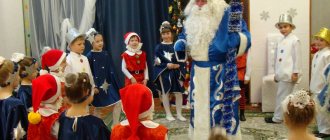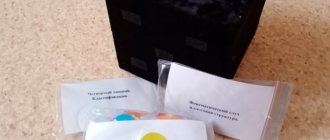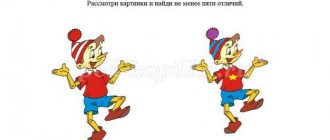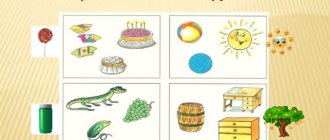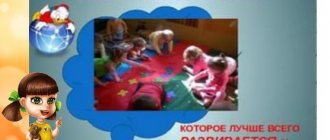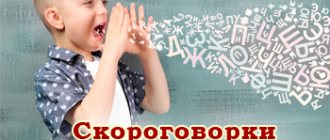Features of speech development 5 – 6 years old
All components of speech at this age are improved, because they are necessary for further school education.
Phonetics: pronunciation of sounds
A 5-year-old child is ready to pronounce all sounds correctly. But some children still cannot master sibilants and “r” (it is replaced with “l”). Moreover, in isolation they can pronounce “r” correctly, but not in words. Even those elements that they always say correctly can “limp” in words with a complex syllable structure.
A characteristic feature of the speech development of a 5-year-old child is that he notices how his friends speak and his own mistakes, that is, he becomes critical.
Vocabulary of preschoolers
It is between 2,500 and 3,000 words. The dictionary is supplemented with generalizing words.
Another feature of speech development at 5–6 years old is that children operate with many concepts. They can name natural phenomena, household items, seasons, professions, types of transport, animals (domestic and wild), birds, fruits and vegetables.
Moreover, they have an idea about, for example, how fruits and vegetables are grown, what changes occur during different seasons, about which animals live in the forest and which on the farm. They orient themselves in space, know the names of months, days of the week, holidays, and traffic rules for pedestrians.
They like to talk about what they see and what is happening. Communication contributes to the development of speech, and vice versa.
They speak simple words correctly, do not change or skip syllables. But complex or unfamiliar words can be distorted.
Grammatical structure of speech
In most cases, children speak in common simple sentences, but complex ones appear. Sentences become more grammatically formed - they contain the main parts of speech.
Collective nouns appear (children, linen, foliage), adjectives that denote the properties and state of things (icy, frozen). Abstract concepts (heartfelt, sweet, kind) are accessible to children.
The following features of speech development are identified at the age of 5–6 years: children correctly use prepositions, conjugate nouns according to cases and numbers, coordinate nouns with numerals (three bullfinches, five chocolates), form possessive adjectives (mother’s, fox).
Children may incorrectly use nouns in the nominative, genitive cases in the plural (pencil - many pencils) and prefixes with spatial meaning (came up, came in, entered). This is considered normal for speech development at this age.
Speech coherence
Preschoolers speak quite coherently, consistently and logically. They can make up a story based on a picture or a series of illustrations, or retell a short story or fairy tale of 50 sentences. They can conduct a monologue and operate with phrases. They have sufficiently developed speech skills to accurately express their thoughts, desires, and share their impressions.
Normal speech development in a 6-year-old child
The following features are characteristic at this age:
- The vocabulary includes up to 3000 words, they are memorized on the fly;
- Children pronounce all sounds;
- The articulatory apparatus is fully formed;
- Word creation is “dying away”;
- They know how to control their voice - tone, volume;
- A simple sound analysis is available: they can find a sound in a word and select words that begin with it;
- They operate with generalizing words, different categories (dishes, transport, seasons, wildlife);
- Development of coherent speech 5 – 6 years.
Engage with your child. Talk a lot, conduct a dialogue, answer questions, read and discuss books, films - all this contributes to the development of speech. Exercises you can do at home are effective.
Sample activities:
I would like to note that the set of classes on the site is not complete and is for informational purposes only. If you want to get full a set of game activities for speech development for children 5-7 years old then write by email or feedback mail.
A set of game activities for speech development for children aged 5-7 years is presented in a Word document in black and white. This is very convenient, because... The training material can be easily printed and modified if desired.
Speech development games at home
We offer a set of exercises. They are held in the form of a game:
- Days of the week. We name the days of the week, clap our hands - one clap per syllable. Then the parent simply claps, and the children guess the day of the week;
- Let's listen to the words. An adult chooses a topic, for example “Farm”, and 3 words on this topic (cow, carrot, field). Then he makes up a story with these words. The task is to jump every time an adult says one of three words;
- Let's rhyme. An adult chooses any word and comes up with rhymes for it. Then he describes him without naming him. For example, “bicycle” is “what is sent to grandparents in a letter” (“hello”). Preschoolers must guess it;
- If I... The adult comes up with phrases that begin with “If I...”, and the children must complete them. “If I go to bed in my clothes”, “If I don’t eat porridge”, “If I suddenly become big”;
- Apple relay. You will need apples with matches. Matches are stuck into the fruit and given to the baby. He must take out a match, describing the apple: red, plump, round, ripe;
- Part and whole. To play you need a ball. The adult throws it to the baby and names a part of some object (fender, screen, steering wheel). The preschooler must immediately say which thing the part belongs to and throw the ball back;
- Finish the word. You will need a ball. The adult throws it to the child and says the initial syllable of any word. The preschooler’s task is to finish the word by throwing the ball back;
- Opposites. We study antonyms. The parent says the word (sweet, big), and the child says the opposite meaning (sour, small). It's even more interesting to play with the ball;
- A hundred questions. Dad or mom takes several items that are well known to the child. For example, a book, a fork, a banana, a toy. You will also need 50 chips. The game consists of the child asking questions about each thing. They can be the most incredible. For each question the kid gets a chip. You can play alone, but it’s more interesting in a group of several people;
- Nonsense. The parent talks about different consoles - non-, mini-, maxi-, anti-, archi-. You need to make sure that the child understands and remembers everything. Then he names any word, and the preschooler must add a prefix from those listed and talk about what has received a new name. For example, an anti-dog: what it is like, where it lives, what it likes, what it looks like. If several children are playing, the adult “distributes” one console to each one, and then says a word - each participant adds his own console to it.
Both one child and several of his friends (up to 6 people) can take part in the games. The more people, the merrier.
Progress of the game: offer to listen to the phrases:
Lexical material:
Beautiful city, beautiful sea, beautiful promenade, beautiful parks
Ask them to guess what you are talking about now:
Beautiful, beautiful, beautiful, beautiful….
Clear sky, clean park, clean street
Ask them to guess what you are talking about now:
Clean, clean, clean...
Offer to come up with your own words for these signs (What else in our city or region can we say is beautiful, clean? etc.).
Game "Which, which, which"
Goal: to improve the skills of word formation of adjectives from nouns.
Symptoms of delayed speech development in children 5–6 years old
The diagnosis of speech development delay (SDD) is made if the speech of a 6-year-old child is far behind age norms. Here are the criteria that can be used to assume that a preschooler has speech development disorders:
- Poor vocabulary: less than 2500 words;
- Cannot make up a story from a picture or retell a story;
- Cannot highlight the main thing in a story;
- Insufficient development of coherent speech 5 – 6 years;
- Does not pronounce sounds;
- The voice is slurred, unclear, monotonous, endings are “swallowed”;
- Cannot evaluate the actions of the hero, compare the heroes of a fairy tale, film, cartoon.
If there are speech development disorders in children 5–6 years old, contact a speech pathologist. Don't wait for your baby to speak up on his own - it won't happen. Therefore, consult a speech therapist as soon as possible and begin correction. After all, with speech development disorders, children have a much harder time with the school curriculum, it is difficult for them to socialize, make friends, and self-esteem decreases over time.
Progress of the game: offer to answer the questions.
Lexical material:
noise of the city - noise (what)
–
(urban)
;
lantern on the street - lantern (what kind)
– …;
park bench - bench (what kind)
– …;
guests of the city - guests (which ones)
– …
sign by the road - sign (what)
— ….
Game "Say the other way around"
Goal: compare objects and phenomena according to temporal and spatial relationships (by size, color and quality, selecting antonyms.
For a child aged 5 years
Parents should know that their little one at the age of five will not focus his interest on any one object. On this basis, when choosing poems, you should focus on works that use things that are understandable to a child. If you need to learn a poem, it should be short and simple.
Where is whose house?
The sparrow lives under the roof, In a warm hole there is a mouse's house. The frog has a house in the pond. A bird's house - a warbler - in the garden. - Hey chicken, where is your house? He is under his mother's wing.
Physical exercises in kindergarten
Horse
I climbed onto the horse and hold on with my hands. Look at me. I went to my mother.
cat house
Ding-dong, ding-dong, The cat's house caught fire. A chicken is running with a bucket, But she didn't get there, She spilled the water.
For a child aged 6 years
Children's poems for speech development. One of the main aspects for a baby is his family. Poems on this topic are very suitable for children aged six. Thanks to these works, the child understands and realizes that it is most correct to value and love in life, and learn to set priorities correctly. Preschoolers will be pleased to read a warm and touching work to their close family members.
Dad
Dad reads books to me. I value my friendship with him. I’ll retell each fairy tale out loud for Dad. I’ll retell it out loud. Then I’ll take the book. I’ll read it aloud to dad. Dad will retell the story. It will take my breath away. That’s how we read to each other. We retell it out loud. And it’s so fun in the apartment. And it’s so fabulous all around.
How to properly develop a child physically while he is small?
Children at this age will be no less interested in riddles about family members.
Who will teach us how to hammer a nail, not as a joke, but seriously? Who will teach you to be brave? If you fall off your bike, don’t whine, And scratch your knee, and don’t cry? Of course... (Dad)
He will always treat you with jam, he will set the table with treats, Lada is our sweetheart, Who? - Dear... (grandmother)
A very relevant topic for children aged six is saying goodbye to kindergarten.
Goodbye, kindergarten!
The kindergarten gave us a lot of knowledge and skills into the world of discoveries, adventures and success! And now we are invited to visit the school - 1st grade! Let learning give you joy every day and every hour!
How to prepare a child for school? What to do? How to practice?
Exercises for general speech development at home
At home, it is imperative to regularly conduct speech therapy classes for children 4-5 years old, the exercises of which include not only the speech part, but also gymnastics for the speech organs and fingers.
Finger gymnastics
This set of simple exercises stimulates the part in the brain center that is responsible for correct speech. This is why fine motor skills classes are needed not only for the little ones, but also for preschoolers.
Finger exercises stimulate the part of the brain responsible for correct speech
All exercises are done 8-10 repetitions:
- “Opening” and “closing” the fingers on each hand. First one by one, then together. You can gradually increase the speed.
- Place your hands on the table: the left one touches the table with the palm, the right one with the back. Then at the same time you need to turn your hands over.
- First, draw a river: fold your hands, palms up, as if you have water in them. Then depict a steamboat - put your palms together, press your thumbs together and lift them up. Then depict the fish that have arrived: press all your fingers together, palms together and make movements with your hands, as if a fish is swimming.
- Draw a tree with branches - arms vertically, fingers spread out in different directions. Then show the roots of the tree - in the same position, move your hands with your fingers down. Then show leaf fall: quickly, quickly clench and unclench your fingers.
Articulation gymnastics
These exercises are aimed at developing the tongue, the main organ responsible for the correct pronunciation of sounds.
Articulation gymnastics for the sound L
Note! Thanks to regular training in articulation gymnastics, the child will soon begin to pronounce even the most difficult sounds.
- Smile as wide as possible, teeth are closed, exactly on top of each other. Stay in this position and count 10 seconds.
- Pull your lips forward and pretend as if an elephant is drawing water with its trunk. Stay for 10 seconds in this position.
- Pretend to be a snake: smile broadly, stick out your tongue like a tube, then hide it back.
- Open your mouth wide and make a clicking sound with your tongue, imitating a horse. At the same time, it is important to ensure that the child’s lower jaw is motionless and only the tongue is working.
- Smile widely, stick out your tongue as far as possible and lightly squeeze it between your teeth. In this position, “pull” the tongue back into the mouth.
- Open your mouth wide, stick out your tongue and pretend to be a clock - move your tongue from one corner of your mouth to the other.
Repeat all these exercises 8-10 times or for 10-15 seconds.
Games for developing phonemic sound
Speech therapy games for 4-5 year old children to develop phonemic sound must be included in daily classes. They are simple and at the same time interesting, and the results will not take long to arrive. After just a month of regular exercises, the quality of children's speech will noticeably improve.
- "Game of Silence" This game is very simple. The child is asked not to make a sound for 2 minutes and close his eyes. As soon as the time is up, then ask the baby to tell what sounds he heard.
- "Clap-stomp." The essence of the game: agree in advance with the child which sound he will stomp on and which sound he will clap on. For example, if he hears the sound [w], then he stomps his foot, if the sound [r], then he claps his palms. Next, the adult names different sounds, and when the child hears the ones he needs, he claps or stomps.
- "Catch the word." The essence of this game is simple: the child is given a word, upon hearing which he will have to clap his hands. Next, the adult names several words in turn that sound similar. As soon as the child hears what he needs, he should clap his hands.
To develop phonemic sound, it is necessary to regularly play speech therapy games
The norm of speech development of children of the fifth year of life
The state of children's speech at the age of four to five years can be very different: from perfect command of the capabilities of their native language to very slurred statements with a meager vocabulary and a lot of grammatical errors.
Guidelines that you can rely on when analyzing the state of children’s speech:
- a child of five years of age uses words exactly according to their meaning;
- in addition to the main parts of speech, he actively uses adjectives, adverbs, and pronouns;
- children can quite fully describe toys, objects, pictures;
- most sounds are pronounced clearly and correctly, although the articulation of [l] and [r] may not yet be mastered;
- he is able to control the volume of his speech and can speak in a whisper;
- the pace of statements is average, without slowness or excessive haste;
- When reciting poetry and telling fairy tales, children use expressive intonation.
In the fifth year of life, children can already speak faster and slower, pronounce words quieter and louder, and notice these nuances in the speech of other people. Kids add an interesting emotional color to their statements and use intonation to express their messages. This allows them to recite poems they have learned by heart with greater artistry.
The main quality of children's speech at this age is its coherence and consistency in the presentation of thoughts.
How to work with your child on speech development: useful tips from my experience of games and activities using a book.
Games and exercises for children's speech development with story-based pictures.
In the article and in the book you will find six series of plot pictures
. Read the text of the assignments in advance and prepare the necessary material.
To complete some tasks, you will need to cut out rectangles from cardboard to the size of the pictures to cover the images. This is done so that the child tries to guess what will happen next or, conversely, to identify the cause of events. This way your baby will learn to establish cause-and-effect relationships, reason, draw conclusions, and prove his point of view. It is very important that the child himself tries to find answers to questions and makes assumptions. Don't be too quick to give the "correct" answer. The baby needs to make a small discovery himself and experience the joy of it.
mistakes
in answering questions , for example, says “prettier” or “brighter,” then do not scold him, do not laugh at the mistake, but tactfully correct him: “Think about how to say it correctly... Yes, you guessed it. We must say “brighter”.
Writing fairy tales from pictures
will help children learn to tell stories in a certain sequence, in accordance with the structure of the story (beginning, middle, end), use figurative expressive means of language, and will contribute to the development of the child’s imagination and creativity.
If it is difficult for a child to compose a fairy tale on his own, then help him. Say the beginning of phrases, and the baby will continue them himself. Look how this was done in the tasks for the pictures “Teddy Bear.” You can help your child by giving him a plan. If there is a long pause during the story, help the child with questions: “What happened to the pig next?” or “Where did the puppy go? Who did he meet?
Game “Guess which word is lost”
? Intended for children five years and older. This fun exercise in an entertaining way will teach your baby to hear and isolate the sounds of his native language from the flow of speech, that is, it will contribute to the development of phonemic hearing. If it is difficult for a child to find the right word, then highlight the wrong word in a couplet and offer to replace it. When selecting rhymes, encourage the child’s independence, do not rush to say the correct answer. Help him with a hint, for example, “Flour-...What is this? (point to the child’s hand).” “Hand!”, the baby will guess. Rejoice at his discovery and repeat these couple of words with him. If a sound in a task needs to be highlighted with a voice, then it is indicated in the text by several letters (“essskimo”, “gradussnik”).
When discussing proverbs with children
It is very important to help the child understand their meaning using specific examples from his life experience, fairy tales, and stories. Think about similar situations your child has been in or observed and talk about them.
not look at several series of pictures at one time with your child.
This leads to overtired children, reducing their interest in classes and their effectiveness. It is enough to talk about one episode and do additional tasks for it, given below. To complete additional tasks you will need toys, pencils or paints, and drawing paper. Prepare them in advance.
After looking at all the series of pictures
ask your child why they say this: “Health is more valuable than gold,” “Take care of your health from a young age.” Invite him to tell you how he takes care of his health, and write a letter to Aibolit about it. The child will dictate, and you will write down his story. Prompt your child to start phrases, and he will continue them. Ask your child to draw pictures for his story for Aibolit.
Additionally, you can conduct games and exercises with your child with subject pictures on the topic “Health”.
Name with your child or find in the pictures:
a) items necessary for the doctor and nurse to work;
b) objects that help us always be clean and tidy;
c) healthy foods.
Ask your child which of these items he has at home and why they are needed. Play the game "Guess the object"
».
Option 1. You describe the object, and the child guesses it. For example: “The doctor needs this item. It is glass, long, it helps to find out whether a person is sick, what his temperature is.” After several riddles, invite your child to tell you a similar riddle himself.
Option 2. The child makes a wish for one object. You try to guess what it is by asking questions. For example: “Is this item a product?” (No). “Does a doctor need this item to treat people?” (Yes). “Is he needed to give injections?” (Yes). "It's a syringe." (Yes). After a while, invite the child to switch roles.
Invite your child to pack his doctor's case. To do this, you need to draw all the objects that he will need for work and explain why he needs them.
I wish you the joy of communicating with your baby and interesting activities and games with him!
You will find a link to download pictures at the end of the article.
A series of pictures for storytelling 1. Teddy bear with a sweet tooth.
Who is in the picture? Call the little bear affectionately ( bear, little bear, little bear, little bear
).
What is the bear doing? What is he like? ( Clubfooted, happy, funny, amusing, cheerful, furry, joyful
).
Look at the second picture. What happened to the bear? How did you guess? Why does the bear have a toothache? Look at the third picture. Who did the bear come to? What does Aibolit do? Why do you need to brush your teeth every day?
Let's tell a fairy tale about this bear cub together: “Once upon a time... He loved to eat very much... One day Mishutka... There was a lot of honey... Teddy Bear... The next day he had... Mishka wandered to... Aibolit taught him... Now Mishutka...”. What can we call our fairy tale? It should be clear from the title what it says.
Honey is sweet. What else could be sweet? Guess my riddle: “Sweet, beautiful – is this a cake or candy?”, “Sweet, fragrant, tasty – is this honey or jam?”, Sweet, chocolate – is this candy or cake? What do you call a person who eats a lot of sweets? ( Gourmand, sweet tooth
).
Which word got lost?
The bear ate a lot of honey. The bear's oak tree is sick. ( Oak-tooth
). Say these lines correctly.
Now let's play rhymes. Replace the first sound in words with the sound z and you will guess the rhyme. For example, oak is a tooth. Try. It's fun and interesting. Mike - ... ( bunny)
, door - ... (
beast
), gave - ... (
hall
), carriage - ... (
pen
), set - ... (
fence
).
Complete the sentences. “We need teeth so that... If there is a lot of sweets, then... Mishutka’s teeth hurt because... I brush my teeth every day so that...”.
Additional task. What should you do to keep your teeth healthy and pain-free? ( Don’t eat a lot of sweets, brush your teeth with toothpaste every day, have your teeth treated by a doctor on time, eat healthy foods: fruits, vegetables, cottage cheese...).
Come up with signs that will help you remember Dr. Aibolit’s advice and draw them. Draw a no sign (for example, crossed out sugar and candy) and an allow sign (for example, a toothbrush and a clock or calendar).
A series of pictures for storytelling 2. How Piggy the pig learned to be neat.
Close the first picture and start looking at the second illustration . How is the piglet feeling? How did you know this? The piglet is crying. How can you say it differently? He...( cries, sheds tears, roars
).
What do you think happened to him? Why is he crying? Let's see if we guessed right or not (open the first picture). What is Piggy doing? What pig? ( Unwashed, sloppy, dirty, unkempt
). Where is he sitting? Have you already guessed why he got sick?
Look at the next picture (third). Who did Piggy come to? What does Aibolit do? Why did he take soap, a brush and a basin of water? Why does he need a towel? Now you will be Aibolit. Tell Piggy what needs to be done so that such troubles don’t happen to him again.
Come up with a fairy tale about how Aibolit taught Khryusha to be neat.
Guess which word is lost.
The pig was dirty. The doctor dug it with soap. ( Soap-snout
). Say these lines correctly.
It's time for a rhyming game. Replace the first sound in words with the sound r and you will guess the rhyme. Soap - ...( dug
), varnish - ... (
crayfish
), mother - ... (
frame
), salt - ... (
role
), cat - ... (
mouth
), flour - ... (
hand
), trunk - ... (robot).
Additional task: Why can’t you eat with dirty hands? Is it possible to eat and at the same time play with sand, with boats in a puddle, with pets? Why? When should you wash your hands? ( After using the toilet, walking, before eating
...). Why do we wash our hands with soap?
What else do you need to do to be clean and tidy? Why do they say: “Sun, air and water are our best friends”? How does water help us be healthy? ( We wash our hands, wash ourselves, bathe, swim, wash clothes, wipe off the dust with a damp cloth, harden ourselves
…).
What would happen if the water disappeared? How do you keep things clean? Draw a picture about helping water. How do fresh air and sun help us be healthy? Why is it useful to walk in the forest or park? Why do you need to ventilate the room?
A series of pictures for storytelling 3. How the puppy learned to get acquainted.
Look at the first picture. What happened on the lawn? What is the chicken's mood? How did you guess? The puppy wanted to meet the chicken, and the chicken got angry with him. How do you think why? What did the puppy do wrong?
Look at the second picture. What happened to the puppy? Why did his nose hurt? Why does the doctor lubricate the wound with iodine? Say in one exhale: “Oh-oh-oh, oh-oh-oh, my nose hurts!” (development of speech breathing). What does a puppy need to remember so that this doesn’t happen to him next time?
Does the chick look like its mother? How are they similar? What is the difference? I'll start, and you finish. The hen has a large beak, and the chicken has a small...( beak
).
The mother has big wings, but the chick has small ones...( wings
).
The hen has long feathers, and the chick has short...( feathers
).
The chicken has a big head, and the chicken has a small...( head)
.
The chicken has a big tail, and the chicken has...( tail
).
Make up a story about how a puppy wanted to meet a chicken and what came of it. What will you call her? It should be clear from the title what your story is about.
Find which word is lost:
Rook anointed his nose with iodine so that the dog could run healthy. ( Rook Doctor
).
Repeat these lines correctly.
Additional task: Do you know how to meet people? What words are you saying? ( Hello. Let's get to know each other. My name is... What's your name? How old are you? What do you like to do? Let's play together
...). Play out an acquaintance scene with toys
A series of pictures for storytelling 4. Bouncing bunny.
Close the second picture. Look at the first illustration. Who is in the picture? Call the little bunny affectionately. ( Bunny, bunny, bunny, bunny, bunny
).
What bunny? ( Cheerful, fluffy, nimble, dexterous, agile
).
The bunny has long ears. How can you say about him? He...( long-eared
).
He has a short tail. Bunny...( short-tailed
).
The hare has big eyes. He...( big-eyed
).
Look at the third picture (the second is still closed). What happened to the bunny? How did you figure this out? Why does Aibolit bandage his paw? Think about what happened to the bunny, how he injured his paw.
Let's see if you guessed right (open the second picture). What happened to the bunny? Why did this happen to him?
Let's come up with a riddle about a bunny. "He's gray like...( mouse
).
He is fluffy like...( cotton wool
).
He is as nimble as... ( a sparrow
). Who is this?". Tell this riddle to your friends.
What do the proverbs “Look before you leap”, “Look at your feet: you won’t find anything, at least you won’t hurt your legs” teach us?
Which word got lost?
The bunny jumped merrily. It's a pity that I broke my hat. (Hat-paw). Say it right.
Let's play rhymes. Replace the first sound in words with the sound l, and you will find a rhyme. Cat -…( spoon
), beetle -...(
bow
), lady -...(
llama
), poppy -...(
crayfish
), helmet -...(
mask
). What sound was hidden from you in the words lllapa, skakallka, sllomall, jumpalll, zabinowall? Think of other words with the sound l.
Additional task: The bunny loves to jump. What outdoor games and exercises do you like? Are they good for health? Do you know why you need to do exercises in the morning? (It drives away sleep, gives cheerfulness, joy, improves health, teaches you to move correctly and beautifully
).
What sports games do you know? What is an athlete who plays football called? ( Football player
).
Hockey? (Hockey player
).
Volleyball? ( Volleyball player
).
Basketball? (Basketball player
).
Tennis? ( Tennis player
).
Swimming? ( Swimmer
).
Skis? ( Skier).
Jumping?
( Jumper
).
A series of pictures for storytelling 5. About sweet ice cream and bitter medicine.
Look at the first picture with your child (the second and third should be closed). What is the squirrel doing? How many servings of ice cream has she already eaten? How do you know? What is the squirrel's mood? ( Cheerful, joyful, cheerful
). Why is she so happy? What could happen to the squirrel next? Why do you think so?
Make up a story about what happened to the squirrel.
Now let's open the second picture. How is the squirrel feeling? What's her mood? Why did she tie the scarf around her throat? Why is she holding a thermometer? What do you think Aibolit will need to cure her? What advice will he give her?
Let's open the third picture. What does Aibolit do? The squirrel drank a spoonful of the mixture and wrinkled its face. What was the mixture? What else could be bitter? When the squirrel ate ice cream, it smiled. What kind of ice cream was it? What's healthier - ice cream or an apple? Candy or carrot? Juice or Fanta? Why?
Which word got lost?
The baby squirrel got sick. She drinks cat medicine. (Spoon cat). Repeat these lines correctly.
Guess what sound occurs in all the words I speak. I ate it, essskimo, thermometer. (Sound c). Clap your hands if you hear the s sound in the word. Mixture, tablet, medicine, glass, scarf, spoon, tail, throat, bag.
Additional tasks. Talk to your child about healthy foods. Offer to play grocery store. Let your child draw a window display for this store. Ask your child why he drew these particular products and why they are useful. Ask which ones he will buy in the store. Together with your child, think about what dishes can be prepared from his products. Create your own book of favorite and healthy dishes. The kid will draw pictures in it, and you will write captions for them.
Features of practicing hissing sounds
To teach a child to correctly pronounce hissing sounds, you must first introduce whistling sounds. If a child in the fourth year of life has learned to pronounce whistling sounds, then there should be no problems with hissing sounds. You can install them with a few simple exercises.
- "Naughty tongue." The child sticks the tip of his tongue out of his mouth. Then he lightly slaps it with his fingers, while saying: “five-five-five.”
- "Delicious jam." The lower lip is pulled down so that the teeth are visible. And the tip of the tongue licks the upper lip, as if it is very sweet there. At the same time, the lower jaw should remain motionless during the exercise.
- “Hide the candy.” Mouth closed. Tighten your tongue and touch your left, then your right cheek. It's like there's candy hiding behind your cheek.
Repeat exercises at least 5 times.
Note! Producing the sounds of native speech is very important for children. It will help them not only make contact with their peers, but also better master the preschool and school curriculum. Parents have the power to help their children avoid difficulties in the future and put the sounds correctly in time.
